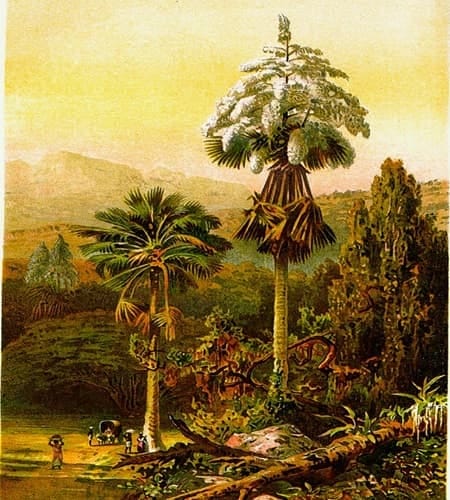Discover the World's Most Intriguing Palm!
Today let's unlock the startling secrets of the Talipot Palm
The Talipot Palm is an extraordinary marvel in the world of botany!
As palm enthusiasts, we often find ourselves enthralled by the beauty and intrigue palms offer. Yet, have we missed out on some of the most fascinating, unique species right under our noses?
Today, we're going to get into the wondrous details of the Talipot Palm. This enormous palm tree has astonishing traits that make it stand out.
Whether you’re a budding palm lover or a seasoned aficionado, this is a journey worth taking!
Let’s see the spectacular highlights of the Talipot Palm! What you’ll learn:
The Talipot Palm With Interesting Facts about its life cycle
Why it’s amidst the zaniest spectacle in the palm universe
How to recognize a Talipot Palm
No longer found in the wild except in association with human habitation.
Robert L Riffle & Paul Craft
Get ready, as we’re about to get into some really cool things!
3 Steps To Expert Talipot ID With Ease
Even if It’s Your First Time Seeing One
There are a few fundamentals you’ll need when getting to know the Talipot Palm.
Explore these essentials to boost your expertise:
Understand Its Unique Blooming Process
The first thing you'll need to know is the Talipot Palm's peculiar blooming process.
This palm blooms just once in its lifetime. Sometime after 30 to 80 years!
When flowering, it produces millions of tiny creamy yellowish & white flowers. No flowering plants on earth have a larger inflorescence (flower stalk) than the Talipot Palm.
But then after blooming and fruiting, the palm begins to die. A singular event that makes it an exhibition worth waiting for.
Witnessing a Talipot Palm bloom is like seeing a shooting star!

You’ll Be Amazed With the Talipot Palm Fronds
Secondly, to help recognize the Talipot Palm, look at it's leaves. They’re massive, circular, and fan-shaped.
The fronds can reach over 20ft/6.1m wide!
Not only are they impressive to behold, but they’ve historically be used as writing or drawing paper.
By focusing on these grand leaves, you’re more likely to spot a true Talipot in the wild.

Locate and Observe
You’re third step is to know where these palms can grow.
Talipot Palms are probably native to southern India and Sri Lanka. They have Been Propagated for so long, that tracing the true origin has been lost.

They grow well only in USDA Zones 10b & 11. Although warmest parts of 10a can work. You’ll find them in botanical gardens around the world. Including:
The Anandashram Garden, a spiritual retreat in Kerala India.
Jardin Botánico de Caracas in Venezuela. Belonging to the University City of Caracas, a World Heritage Site.
Near Deering Bay Florida, in the northeast area of Palmetto Bay FL.
Royal Botanic Gardens Peradeniya in Sri Lanka, by the Mahaweli River.
While in Rio de Janeiro Brazil, Jardim Botânico, a UNESCO biosphere reserve.
Jardin Botanique de Deshaies, the Botanical Garden in the islands of Guadeloupe, West Indies.
At the Pamplemousse Garden on the island Republic of Mauritius.
In Hawaii at
Foster Botanical Gardens in Honolulu.
The relatively new Ho'Omaluhia Botanical Garden in Kaneohe Oahu.
If you’re visiting any of these regions or other environments where they’re grown (perhaps your own nearby garden), spend some time observing these giants.
The reason we recommended all these places to see them, is to recommend taking some time to visit them. Show yourself aside a palm among the largest of palms in the entire world!
Please let us know if you were amazed by this palm’s life story!
Check These Resources
* The Talipot Palm: A Living Giant is a palm you can grow, if you have room! Watch for them to begin propagation
* Talking about Seeing One in Key West Florida.
Reviewing what we went over today
The Talipot Palm blooms once after a long life.
It can be identified by its massive leaves & thick trunk.
Observing them in their natural habitat offers valuable insights.
We recommend checking one out, on A Trip to Tropical Places, or at your nearest Botanical Garden!






How extraordinary to go to all that effort to grow so big only to flower once and die! This reminded me of the banana palms we have in our garden. They do similar. A trunk flowers once, fruits and dies. Then a new trunk grows.
I don't think we have this palm in NZ. I had a quick search but couldn't find a reference to it.